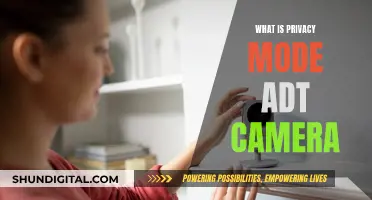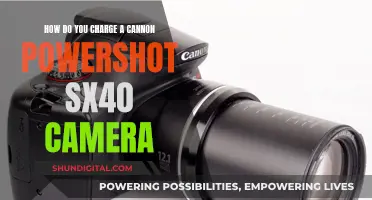
Apple does not manufacture any surveillance products, but it does offer software that allows for the management of security cameras and related devices. This software provides basic motion detection, alerts, and other functionalities. While Apple does not produce its own surveillance cameras, there are several third-party cameras that are compatible with Apple's HomeKit platform, which offers enhanced security measures and end-to-end encryption for data protection.
| Characteristics | Values |
|---|---|
| Surveillance camera compatibility | Apple HomeKit and Siri |
| Surveillance camera brands | Eufy, Arlo, Eve, Aqara, Ecobee, Logitech, Netatmo, Wemo |
| Video storage | iCloud+ subscription, microSD card, local storage, cloud storage |
| Two-way audio | Available with some cameras |
| Object recognition | People, animals, vehicles, packages |
| Face recognition | Available with some cameras |
| Motion detection | Available with some cameras |
| Wireless range | Issues with HSV-enabled cameras |
What You'll Learn

Apple's HomeKit platform
Apple's smart home platform, HomeKit, allows you to control various internet-connected home devices, ranging from thermostats and plugs to window blinds, light bulbs, and more, with Apple devices.
HomeKit is not a product or software but a framework that links smart home products together and adds new capabilities to devices like lights, locks, cameras, thermostats, plugs, and more. HomeKit lets you control smart home products using apps on your iPhone, iPad, or Mac, or simple Siri voice commands.
HomeKit devices connect to your HomeKit setup through Bluetooth, Wi-Fi, Thread, or a hub that connects to Wi-Fi. Many HomeKit devices in the United States use Wi-Fi or connect to a hub over Wi-Fi. There are also some devices that connect over Bluetooth, and it is worth noting that you will need home hubs to extend connectivity; otherwise, connection range can be rather limited. Home hubs include the Apple TV, iPad, and HomePod.
To get started with HomeKit, you need to purchase any HomeKit-enabled device, such as a smart plug, light bulb, AirPlay 2 speaker, Apple TV, HomePod, HomePod mini, thermostat, or something else. Then, open the "Home" app, which comes pre-installed on all iOS devices, and tap the "Add Accessory" button on the main screen. Follow the steps to scan the HomeKit QR code on the device to add it to the HomeKit framework.
HomeKit setups, scenes, and automations can be as complex or as simple as you like. For example, you can create a "Good night" scene that makes sure the doors are locked, closes the garage, turns off the lights, lowers the thermostat, and then activates a night light whenever motion is detected. With automation, you can set individual HomeKit devices to come on or off at specific times, or you can set entire scenes to come on at a certain time.
Apple takes security and privacy seriously, and every manufacturer that creates a HomeKit-compatible device must follow Apple's security guidelines. All HomeKit devices use the same security features, including end-to-end encryption, non-reusable encryption keys, and two-way authentication when connecting to a HomeKit setup.
To control your HomeKit devices when away from home, you will need an Apple TV, iPad, HomePod, or HomePod mini to serve as a Home Hub.
Editing Essentials: Camera Raw CS3 Techniques
You may want to see also

Apple HomeKit Secure Video (HSV)
To use HSV, you need a HomeKit-supported camera, a home hub, and an iCloud subscription. The home hub can be a HomePod mini, HomePod, or Apple TV. You can also use an iPad as your hub, although this is not recommended. The iCloud subscription options are as follows:
- 50 GB plan ($1 or £1 a month) for one camera
- 200 GB plan ($3 or £3 a month) for up to five cameras
- 2 TB plan ($10 or £9 a month) for unlimited cameras
Apple's new iCloud+ plans support unlimited HSV cameras, and the camera footage does not count towards your iCloud storage limit.
While HSV offers enhanced security and privacy for your camera footage, it also has some limitations and shortcomings. One major issue is that HSV cameras often fail to detect motion and miss motion events that should have triggered a recording. This has been a consistent problem across different brands of HSV cameras. Additionally, HSV limits compatibility by not supporting Alexa or Google Assistant voice commands. It also does not support smart displays, so you cannot view footage or manage camera settings on devices like the Echo Show or Google Nest.
Another limitation of HSV is that it reduces video quality by only supporting 1080p-resolution video. This can be a disadvantage compared to 2K and 4K cameras that are now commonly available. HSV also does not allow fine-tuning of motion detection, as the important feature of adjusting motion-detection sensitivity is not available. This can lead to frequent nuisance alerts, making the use of the security camera impractical.
In conclusion, while Apple's HomeKit Secure Video offers enhanced security and privacy for camera footage, it also has some notable limitations and issues with motion detection.
Are Camera Speeding Tickets Worth Contesting in Court?
You may want to see also

Apple's iCloud service
ICloud is built into every Apple device and provides 5GB of free storage to back up your data and keep your personal information synced across multiple platforms. This includes backing up important data on your iPhone and iPad, such as your favourite apps, which are automatically updated whenever your device is connected to a power source, Wi-Fi, or both.
For those seeking additional storage and enhanced privacy features, Apple offers iCloud+, a premium subscription service with several plans to choose from. iCloud+ provides increased storage capacity ranging from 50GB to 12TB, allowing ample space for photos, videos, files, and backups. It also includes access to advanced features such as iCloud Private Relay, Hide My Email, Custom Email Domain, and HomeKit Secure Video.
HomeKit Secure Video is a notable feature that seamlessly integrates with your home security system. It enables the recording, analysis, and secure encryption of footage from your security cameras. This footage can be easily accessed and viewed through the Home app from anywhere, ensuring that your video data remains private and accessible only to those you choose.
Additionally, iCloud+ offers family sharing, allowing up to five family members to share a single subscription while maintaining separate and private files, documents, and personal information.
Overall, Apple's iCloud service provides a robust and secure platform for storing and syncing data across Apple devices, with iCloud+ offering enhanced storage and privacy features for a more comprehensive experience.
Charging Your SQ11 Camera: How Long Does It Take?
You may want to see also

Apple Home app
Apple's Home app is a smart home management system that allows users to control and monitor connected smart devices. The app is designed to work with Apple devices such as iPhones, iPads, Apple Watches, HomePods, and Apple TVs. It provides a centralised platform for users to manage various smart home accessories, including lights, security systems, climate control, speakers, and TVs.
One of the key features of the Home app is its ability to support multiple cameras, offering a multi-camera view of up to four cameras simultaneously in the Home tab. This enables users to quickly check the status of different rooms or areas. The app also includes a Grid Forecast feature, which uses local electric grid data to inform users when cleaner energy sources are in use, helping them plan the use of appliances or charging devices accordingly.
The Home app also integrates with Siri, allowing for voice control of smart devices. Users can give voice commands to control accessories, such as locking doors or playing music in specific rooms. Additionally, the app offers widgets and a Control Center for quick access to frequently used accessories and scenes.
Security and privacy are important aspects of the Home app. It supports HomeKit Secure Video, which enables users to view live footage and receive notifications when people, pets, vehicles, or packages are detected by security cameras or video doorbells. The app also provides a 10-day recording history, allowing users to review, share, or save recordings. Furthermore, data stored within the Home app is encrypted, ensuring that only authorised individuals can access it.
The Home app can be used to set up automations and create custom scenes. For example, users can automate locking all doors at bedtime or turning on lights at sunset. It also allows for guest access, where permissions can be assigned to trusted individuals for door locks, garage doors, and alarm systems.
To add accessories to the Home app, users need to ensure their iPhone or iPad is updated to the latest iOS or iPadOS version with Bluetooth enabled. Accessories must support HomeKit, AirPlay, or Matter, and be connected to the same Wi-Fi network as the user's Apple devices. The app also requires the setup of a home hub, such as a HomePod, HomePod mini, or Apple TV, to unlock the full potential of the smart home ecosystem.
The Evolution of HD Cameras: A Historical Perspective
You may want to see also

Apple's HomeKit device
Apple's HomeKit, also known as Apple Home, is a software framework and communication protocol that allows users to configure, communicate with, and control smart home appliances using Apple devices. It was first introduced in 2014 and has since expanded to support a wide range of devices.
The HomeKit system is designed to make tasks inside the home easier and provide users with the tools to adapt their home capabilities to their specific needs and desires. With HomeKit, users can automate daily tasks by scheduling them ahead of time or using voice commands with their Apple HomePod smart speaker. For example, users can dim their lights, adjust the room temperature, turn devices on or off, and control smart locks and security systems.
The Apple Home app, available on iOS devices, serves as a central hub for controlling and managing HomeKit-compatible devices. Users can organize accessories by room, manage multiple accessories simultaneously, and control their home with Siri.
While HomeKit may not be as popular or have as many compatible devices as Amazon Alexa or Google Home, it offers a streamlined and user-friendly smart home experience. Apple's platform is known for its speed, as HomeKit processes data locally instead of in the cloud.
- Apple HomePod mini: Apple's entry-level smart speaker that doubles as a speedy smart home hub.
- Apple TV 4K (2022): A streaming device with a powerful processor, offering fast load times and seamless integration with HomeKit.
- Apple HomePod (2nd Generation): Apple's premium smart speaker with built-in support for Matter and temperature and humidity sensors.
- Wemo WiFi Smart Plug: A compact and affordable smart plug that works with major smart assistants, including HomeKit.
- Schlage Encode Plus: A smart lock that can be unlocked using an Apple Watch or iPhone, even if the device's battery is dead.
- Ecobee SmartThermostat: A smart thermostat with built-in Alexa and direct Siri connectivity, offering remote control and excellent remote sensor range and battery life.
- Lutron Caseta Dimmer Switch Starter Kit: This kit turns "dumb" devices smart by allowing control over desk or table lamps, with the ability to dim the bulbs.
- Brilliant Smart Home Controller: Acts as a universal remote for connected smart home devices and offers motion sensors and a video intercom.
- Philips Hue White A19 Starter Kit: A smart lighting kit that includes two bulbs and a hub, offering easy pairing and bright lighting (up to 800 lumens).
- Chamberlain myQ: A smart garage door opener that allows users to open and close their garage doors using Siri voice commands.
The First Camera: A Visionary's Spark
You may want to see also
Frequently asked questions
No, Apple does not develop, produce, or manufacture any surveillance products. However, Apple products can be integrated into a security camera system by being used as a recorder or for streaming.
Yes, depending on the brand of your surveillance system, you may be able to stream your security cameras from a MacBook or integrate it into the security camera system.
For a single camera, you can use a USB or HDMI connection. For multiple cameras, you will need a switch to manage the channels. Many brands also allow for a direct wireless connection to a computer over a given network when it comes to IP cameras.
No, most laptops are not built to provide power over ethernet capabilities to a given IP camera.







